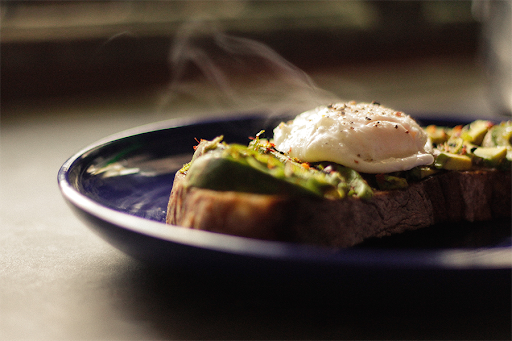
A Science Experiment for Dinner
By Marika Yang
Media InquiriesThere are lots of ways to cook food, like frying bacon on a skillet, roasting vegetables in the oven, or steaming rice in a pot. But the easiest—though perhaps not the most reliable—way to prepare food is in the microwave.
A fan of food documentaries, Haojian Jin, a Ph.D. candidate in human-computer interaction, began thinking about how the fundamental nature of cooking is heating, which is achieved with various methods. Inspired by restauranteur David Chang and his advocacy for incorporating science in the world of cooking, Jin looked back at the three types of heating methods taught in high school physics class: conduction, convection, and radiation.
The most familiar example of conduction in cooking is a pan over a stove; examples of convection cooking is steaming or baking with a convection oven. These two methods aren’t easily software programmable, leaving the last method, radiation, or as it is commonly used in family kitchens, the microwave.
“We realized the microwave is the best tool for cooking,” said Jin, who is co-advised by Swarun Kumar, assistant professor of electrical and computer engineering, and Jason Hong, a professor in the Human-Computer Interaction Institute. “It’s so convenient, but the only issue is that it cannot cook food well.”
A microwave does not heat food evenly. Though turntables help remediate this, the food remains inconsistently heated. It is hard to predict which part of the food will be overheated or underheated. Looking at this issue, Jin collaborated with Kumar, Hong, and Jingxian Wang, a Ph.D. candidate in electrical and computer engineering. They asked: How can we heat food uniformly in a microwave?
They began to develop SDC—Software-Defined Cooking—a low-cost closed-loop microwave system that is programmed to heat food uniformly. The team’s paper was accepted at the MobiCom 2019 conference held in October 2019. Their work was also featured in the ACM GetMobile magazine this year, one of a select group of mobile systems papers. The research was supported by a grant from the National Science Foundation.
The microwave is equipped with 32 neon lights inserted under a programmable turntable. When the microwave is turned on, the magnetic field powers the neon lights. As the microwave works and the turntable rotates, some neon lights glow, some do not. The glowing lights indicate areas with a strong electromagnetic (EM) field and therefore a strong heating power. The food in those areas are heated quickly. The areas with lights that are not glowing have little heating power, leading to cold spots in the food.
“This shows us what the heating power looks like inside the microwave in real-time,” said Jin. “Outside the microwave, we have a camera system that analyzes the light signals in real-time and decides how to locate heating power to different positions by moving the turntable.”
To test SDC, Jin heated raw rice with three microwave methods: no rotation, default rotation, and SDC. To visualize this experiment, he colored the rice grains with a thermal-chromatic pigment that turns pink as temperature increases. With each method, the rice turns a deeper shade of pink as the heating time increases. After just 30 seconds of SDC, much of the rice is uniformly pink, while the rice of the other two methods still have distinct sections of gray, the cold spots.
The team also developed SDC to consider different heating requirements within the same food or recipe. For example, the best way to cook bacon is to burn the fat area without burning the meat area. They tested SDC by analyzing how it cooks bacon compared to a normal microwave. In the experiment, a normal microwave heated the bacon unevenly, causing it to shrink randomly. SDC heated the meat and fat areas discriminatively, intentionally burning fat areas, causing them to shrink significantly, while the meat area heated with its shape intact.
Jin has felt a positive reaction to the system. As the team works to improve the prototype, they are looking at how it could be incorporated into commercial products in the future.
“I see it as an enabling technology that helps chefs cook food in a different way,” he said.